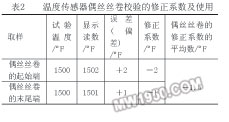Third, AMS2750D "high temperature measurement" specification of the requirements and requirements for temperature sensor certification 1. Regulations and requirements The temperature sensor should have a certificate (as shown in Figure 1). The certificate should indicate: the source of the calibration data, the nominal test temperature, the actual test temperature reading, the calibration method, and the temperature correction factor for each calibration. (The factor should be traceable to NIST or other recognized national standards). Figure 1 Certificate of temperature sensor 2. Analysis and discussion Ordering notes for temperature sensor harness (couple wire) and temperature sensor: first, fully understand and specify the specific requirements of the customer; second, understand and specify the end use (such as: primary, secondary, test, work, charge, etc.) Third; understand and clarify the scope of accurate use; fourth, clear test arrangements with suppliers (check frequency); fifth, understand and specify the type of wiring harness and type of insulation; sixth, ensure verification certificate Meet the requirements. Fourth, AMS2750D "high temperature measurement" specification in the specification of the conversion between degrees 毫 - millivolts and requirements Conversion from millivolts to degrees and from degrees to millivolts shall be in accordance with ASTM E 230 or other national standards. 5. Regulations and requirements for temperature sensor calibration in AMS2750D "High Temperature Measurement" specification 1. Regulations and requirements The temperature sensor should be calibrated over its operating temperature range. Except for those temperature sensors that are calibrated at fixed points in accordance with ASTM MNL 12 or other national standards, the calibration temperature interval for all other temperature sensors should not exceed 140 °C. Repeated verification of K-type temperature sensor and E-type temperature sensor used at temperatures above 260 °C is prohibited. For corrections above the highest calibration temperature or below the minimum calibration temperature, the correction value (correction factor) of the temperature is not allowed to be obtained by extrapolation (epitaxial method). 2. Analysis and discussion The temperature range of the temperature sensor must meet the following requirements: the calibration test temperature point must be within the temperature range determined by the end use; the lower temperature test point should be equal to or lower than the lowest value of the required operating temperature range; Higher test points must be equal to or greater than the highest value of the required operating temperature range; the temperature separation between any two temperature test points should not exceed 140 °C. Temperature sensors rarely display the "real" temperature of the furnace (equipment) because temperature sensors typically have some tolerance when used. Therefore, in order to obtain "real" temperature information of the furnace (equipment), the error of the temperature sensor must be corrected. Deviation: The difference (deviation) between the uncorrected indicated temperature and the actual (true) temperature. Correction factor (check correction value): is the temperature value determined by the closest calibration (sometimes also appears as a coefficient). Used to adjust the temperature sensor reading (ie, add the correction factor to the display reading to get the actual temperature) to reflect the actual temperature tested (see Table 2 for details), which should be provided with the temperature sensor certificate. The relevant documentation provided by the temperature sensor supplier must clearly state how the correction factor is calculated and used. Previous Next
Detergent is a product that is specially prepared by cleaning the process for cleaning. The main components are usually composed of surfactant, detergent and Additives. There are many kinds of detergents, according to the type of dirt removal, which can be divided into heavy scale detergent and light scale detergent. According to the appearance of the product can be divided into powder, block, paste, pulp and liquid and other forms.
Laundry Liquid,Laundry Powder,Neutral Detergent,Soapy Detergent SHANDONG ZHISHANG CHEMICAL CO.LTD , http://www.zhishangchemical.com

